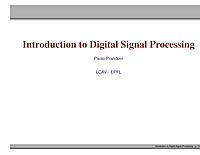
Wavelet Denoising for TDR Dynamic Range Improvement
A technique is presented for removing large amounts of noise present in time-domain-reflectometry (TDR) waveforms to increase the dynamic range of TDR waveforms and TDR based s-parameter measurements.
Bilinear Transformation Made Easy
A formula is derived and demonstrated that is capable of directly generating digital filter coefficients from an analog filter prototype using the bilinear transformation. This formula obviates the need for any algebraic manipulation of the analog prototype filter and is ideal for use in embedded systems that must take in any general analog filter specification and dynamically generate digital filter coefficients directly usable in difference equations.

FUZZY LOGIC BASED CONVOLUTIONAL DECODER FOR USE IN MOBILE TELEPHONE SYSTEMS
Efficient convolutional coding and decoding algorithms are most crucial to successful operation of wireless communication systems in order to achieve high quality of service by reducing the overall bit error rate performance. A widely applied and well evaluated scheme for error correction purposes is well known as Viterbi algorithm [7]. Although the Viterbi algorithm has very good error correcting characteristics, computational effort required remains high. In this paper a novel approach is discussed introducing a convolutional decoder design based on fuzzy logic. A simplified version of this fuzzy based decoder is examined with respect to bit error rate (BER) performance. It can be shown that the fuzzy based convolutional decoder here proposed considerably reduces computational effort with only minor BER performance degradation when compared to the classical Viterbi approach.
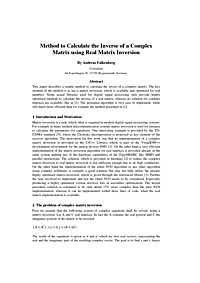
Method to Calculate the Inverse of a Complex Matrix using Real Matrix Inversion
This paper describes a simple method to calculate the invers of a complex matrix. The key element of the method is to use a matrix inversion, which is available and optimised for real numbers. Some actual libraries used for digital signal processing only provide highly optimised methods to calculate the inverse of a real matrix, whereas no solution for complex matrices are available, like in [1]. The presented algorithm is very easy to implement, while still much more efficient than for example the method presented in [2]. [1] Visual DSP++ 4.0 C/C++ Compiler and Library Manual for TigerSHARC Processors; Analog Devices; 2005. [2] W. Press, S.A. Teukolsky, W.T. Vetterling, B.R. Flannery; Numerical Recipes in C++, The art of scientific computing, Second Edition; p52 : “Complex Systems of Equations”;Cambridge University Press 2002.

Real Time Implementation of Multi-Level Perfect Signal Reconstruction Filter Bank
Discrete Wavelet Transform (DWT) is an efficient tool for signal and image processing applications which has been utilized for perfect signal reconstruction. In this paper, twenty seven optimum combinations of three different wavelet filter types, three different filter reconstruction levels and three different kinds of signal for multi-level perfect reconstruction filter bank were implemented in MATLAB/Simulink. All the filters for different wavelet types were designed using Filter Design Analysis (FDA) and Wavelet toolbox. Signal to Noise Ratio (SNR) was calculated for each combination. Combination with best SNR was then implemented on TMS320C6713 DSP kit. Real time testing of perfect reconstruction on DSP kit was then carried out by two different methods. Experimental results accede with theory and simulations.
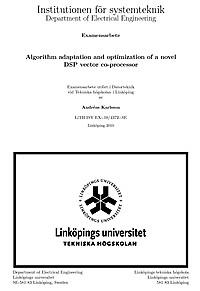
Algorithm Adaptation and Optimization of a Novel DSP Vector Co-processor
The Division of Computer Engineering at Linköping's university is currently researching the possibility to create a highly parallel DSP platform, that can keep up with the computational needs of upcoming standards for various applications, at low cost and low power consumption. The architecture is called ePUMA and it combines a general RISC DSP master processor with eight SIMD co-processors on a single chip. The master processor will act as the main processor for general tasks and execution control, while the co-processors will accelerate computing intensive and parallel DSP kernels.This thesis investigates the performance potential of the co-processors by implementing matrix algebra kernels for QR decomposition, LU decomposition, matrix determinant and matrix inverse, that run on a single co-processor. The kernels will then be evaluated to find possible problems with the co-processors' microarchitecture and suggest solutions to the problems that might exist. The evaluation shows that the performance potential is very good, but a few problems have been identified, that causes significant overhead in the kernels. Pipeline mismatches, that occurs due to different pipeline lengths for different instructions, causes pipeline hazards and the current solution to this, doesn't allow effective use of the pipeline. In some cases, the single port memories will cause bottlenecks, but the thesis suggests that the situation could be greatly improved by using buffered memory write-back. Also, the lack of register forwarding makes kernels with many data dependencies run unnecessarily slow.
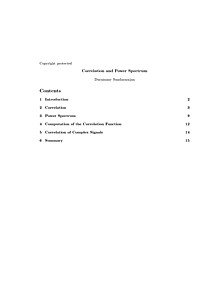
Correlation and Power Spectrum
In the signals and systems course and in the first course in digital signal processing, a signal is, most often, characterized by its amplitude spectrum in the frequency-domain and its amplitude profile in the time-domain. So much a student gets used to this type of characterization, that the student finds it difficult to appreciate, when encountered in the ensuing statistical signal processing course, the fact that a signal can also be characterized by its autocorrelation function in the time-domain and the corresponding power spectrum in the frequency-domain and that the amplitude characterization is not available. In this article, the characterization of a signal by its autocorrelation function in the time-domain and the corresponding power spectrum in the frequency-domain is described. Cross-correlation of two signals is also presented.
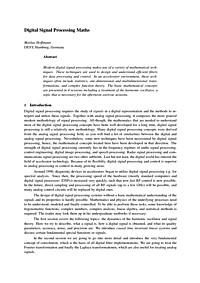
Digital Signal Processing Maths
Modern digital signal processing makes use of a variety of mathematical techniques. These techniques are used to design and understand efficient filters for data processing and control.
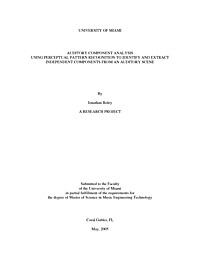
Auditory Component Analysis Using Perceptual Pattern Recognition to Identify and Extract Independent Components From an Auditory Scene
The cocktail party effect, our ability to separate a sound source from a multitude of other sources, has been researched in detail over the past few decades, and many investigators have tried to model this on computers. Two of the major research areas currently being evaluated for the so-called sound source separation problem are Auditory Scene Analysis (Bregman 1990) and a class of statistical analysis techniques known as Independent Component Analysis (Hyvärinen 2001). This paper presents a methodology for combining these two techniques. It suggests a framework that first separates sounds by analyzing the incoming audio for patterns and synthesizing or filtering them accordingly, measures features of the resulting tracks, and finally separates sounds statistically by matching feature sets and making the output streams statistically independent. Artificial and acoustical mixes of sounds are used to evaluate the signal-to-noise ratio where the signal is the desired source and the noise is comprised of all other sources. The proposed system is found to successfully separate audio streams. The amount of separation is inversely proportional to the amount of reverberation present.
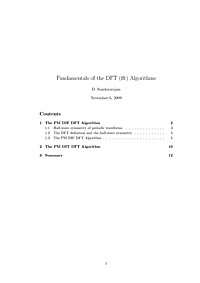
Fundamentals of the DFT (fft) Algorithms
In this article, a physical explanation of the fundamentals of the DFT (fft) algorithms is presented in terms of waveform decomposition. After reading the article and trying the examples, the reader is expected to gain a clear understanding of the basics of the mysterious DFT (fft) algorithms.
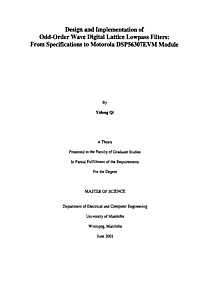
Design and implementation of odd-order wave digital lattice lowpass filters, from specifications to Motorol DSP56307EVM module
This thesis is dedicated to applying and developing explicit formulas for the design and implementation of odd-order lattice Lowpass wave digital filters (WDFs) on a Digital Signal Processor (DSP), such as a Motorola DSP56307EVM (Evaluation Module). The direct design method of Gazsi for filter types such as Butterworfh, Chebyshev, inverse Chebyshev, and Cauer (Elliptic) provides a straightforward method for calculating the coefficients without an extensive knowledge of digital signal processing. A program package to design and implement odd-order WDFs, including detailed procedures and examples, is presented in this thesis and includes not only the calculations of the coefficients, but also the simulation on a MATLAB platform and an implementation on a Motorola DSP56307EVM board. It is very quick, effective and convenient to obtain the coefficients when the user enters a few parameters according to the general specifications; to verify the characteristics of the designed filter; to simulate the filter on the MATLAB platform; to implement the filter on the DSP board; and to compare the results between the simulation and the implementation.
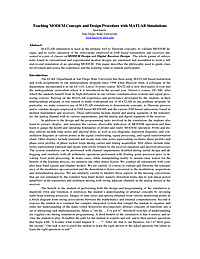
Teaching MODEM Concepts and Design Procedure with MATLAB Simulations
MATLAB simulation is used as the primary tool to illustrate concepts, to validate MODEM designs, and to vent' operation of the subsystems employed in DSP based transmitters and receivers presented in a pair of classes on MODEM Design and Digital Receiver Design. The whole gamut of subsystems found in conventional and experimental modem designs are simulated and assembled to form a full end-to-end simulation of an operating MODEM. This paper describes the philosophy used to guide class involvement and assess the experience and the learning value to student participants.
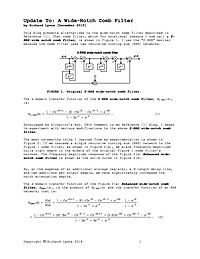
Update To: A Wide-Notch Comb Filter
This article presents alternatives to the wide-notch comb filter described in Reference [1].
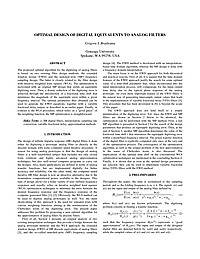
OPTIMAL DESIGN OF DIGITAL EQUIVALENTS TO ANALOG FILTERS
The proposed optimal algorithm for the digitizing of analog filters is based on two existing filter design methods: the extended window design (EWD) and the matched–pole (MP) frequency sampling design. The latter is closely related to the filter design with iterative weighted least squares (WLS). The optimization is performed with an original MP design that yields an equiripple digitizing error. Then, a drastic reduction of the digitizing error is achieved through the introduction of a fractional time shift that minimizes the magnitude of the equiripple error within a given frequency interval. The optimal parameters thus obtained can be used to generate the EWD equations, together with a variable fractional delay output, as described in an earlier paper. Finally, in contrast to the WLS procedure, which relies on a “good guess” of the weighting function, the MP optimization is straightforward.

FUZZY LOGIC BASED CONVOLUTIONAL DECODER FOR USE IN MOBILE TELEPHONE SYSTEMS
Efficient convolutional coding and decoding algorithms are most crucial to successful operation of wireless communication systems in order to achieve high quality of service by reducing the overall bit error rate performance. A widely applied and well evaluated scheme for error correction purposes is well known as Viterbi algorithm [7]. Although the Viterbi algorithm has very good error correcting characteristics, computational effort required remains high. In this paper a novel approach is discussed introducing a convolutional decoder design based on fuzzy logic. A simplified version of this fuzzy based decoder is examined with respect to bit error rate (BER) performance. It can be shown that the fuzzy based convolutional decoder here proposed considerably reduces computational effort with only minor BER performance degradation when compared to the classical Viterbi approach.

Real Time Implementation of Multi-Level Perfect Signal Reconstruction Filter Bank
Discrete Wavelet Transform (DWT) is an efficient tool for signal and image processing applications which has been utilized for perfect signal reconstruction. In this paper, twenty seven optimum combinations of three different wavelet filter types, three different filter reconstruction levels and three different kinds of signal for multi-level perfect reconstruction filter bank were implemented in MATLAB/Simulink. All the filters for different wavelet types were designed using Filter Design Analysis (FDA) and Wavelet toolbox. Signal to Noise Ratio (SNR) was calculated for each combination. Combination with best SNR was then implemented on TMS320C6713 DSP kit. Real time testing of perfect reconstruction on DSP kit was then carried out by two different methods. Experimental results accede with theory and simulations.

Auditory Component Analysis Using Perceptual Pattern Recognition to Identify and Extract Independent Components From an Auditory Scene
The cocktail party effect, our ability to separate a sound source from a multitude of other sources, has been researched in detail over the past few decades, and many investigators have tried to model this on computers. Two of the major research areas currently being evaluated for the so-called sound source separation problem are Auditory Scene Analysis (Bregman 1990) and a class of statistical analysis techniques known as Independent Component Analysis (Hyvärinen 2001). This paper presents a methodology for combining these two techniques. It suggests a framework that first separates sounds by analyzing the incoming audio for patterns and synthesizing or filtering them accordingly, measures features of the resulting tracks, and finally separates sounds statistically by matching feature sets and making the output streams statistically independent. Artificial and acoustical mixes of sounds are used to evaluate the signal-to-noise ratio where the signal is the desired source and the noise is comprised of all other sources. The proposed system is found to successfully separate audio streams. The amount of separation is inversely proportional to the amount of reverberation present.
Optimization of Synthesis Oversampled Complex Filter Banks
An important issue with oversampled FIR analysis filter banks (FBs) is to determine inverse synthesis FBs, when they exist. Given any complex oversampled FIR analysis FB, we first provide an algorithm to determine whether there exists an inverse FIR synthesis system. We also provide a method to ensure the Hermitian symmetry property on the synthesis side, which is serviceable to processing real-valued signals. As an invertible analysis scheme corresponds to a redundant decomposition, there is no unique inverse FB. Given a particular solution, we parameterize the whole family of inverses through a null space projection. The resulting reduced parameter set simplifies design procedures, since the perfect reconstruction constrained optimization problem is recast as an unconstrained optimization problem. The design of optimized synthesis FBs based on time or frequency localization criteria is then investigated, using a simple yet efficient gradient algorithm.
HIERARCHICAL MOTION ESTIMATION FOR EMBEDDED OBJECT TRACKING
This paper presents an algorithm developed to provide automatic motion detection and object tracking embedded within intelligent CCTV systems. The algorithm development focuses on techniques which provide an efficient embedded systems implementation with the ability to target both FPGA and DSP devices. During algorithm development constraints on hardware implementation have been fully considered resulting in an algorithm which, when targeted at current FPGA devices, will take full advantage of the DSP resource commonly provided in such devices. The hierarchical structure of the proposed algorithm provides the system with a multi-level motion estimation process allowing low resolution estimation for motion detection and further higher resolution stages for motion estimation. An initial MATLAB prototype has demonstrated this algorithm capable of object motion estimation while compensating for camera motion, allowing a moving object to be tracked by a moving camera.








